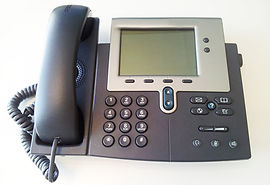Virtual cloud telephone systems
plus Mobile phones as private branch exchanges ...
Deutsche Telekom wants to switch its network to All IP by the end of 2018 - ISDN will then be a thing of the past. Almost four million Telekom customers have to look for an alternative. The days of the classic telecommunications network are numbered, the future should belong to SIP trunking. We show you what you should know about the ISDN alternative SIP trunking.
SIP trunking has received a lot of attention in recent years and is becoming more and more important. According to ours Management consultant for Voice over IP, Unified Communications and Information Management Systems at SNU SABINE NIXDORF GmbH , the acceptance of SIP trunking is increasing because companies are trying to improve the reliability of their communication services while reducing their costs.
But what exactly is SIP trunking? What can SIP trunking do, what are the advantages and disadvantages of it? Which companies should consider SIP trunking and why? What should you watch out for when converting to SIP trunking?
The following essential facts and tips about SIP trunking summarize the answers to these questions and what you should know about SIP trunking:
1. SIP trunks and PSTN
SIP trunks are the means of choice for connecting several connection points and for joining the Public Switched Telephone Network (PSTN). A SIP trunk is an IP connection between an enterprise unified communications system and a SIP trunking service provider via the Session Border Controller (SBC). The trunks end either centrally, for example in the company's central data center, or locally in smaller branches.
2. SIP trunks replace TDM and H.323 trunks
With SIP trunks, old Time Division Multiplexing (TDM) trunks can be completely replaced, connections can be consolidated in the PSTN and Unified Communications (UC) with all available features can be rolled out company-wide. SIP trunks are the third stage in the evolution of Voice-over-IP trunking and follow on from TDM and H.323 trunks.
3. 40 percent savings potential
With SIP trunks you can save on access costs on the one hand, and on actual traffic costs on the other. Depending on the existing structure, the savings potential ranges between 10 and 40 percent. There are many reasons for savings: These include the elimination of primary rate access gateways, the elimination of various contracts with several service providers and lower running costs. The central billing and communication with a provider ensure a quick overview of the expenses for telephony and UC.
4. SIP trunks as a turbo for UC strategies
SIP trunks enable the implementation of UC throughout the company because they seamlessly integrate functionalities such as presence display and multi-channel communication. In fact, the savings that can be achieved with SIP trunking are now even used by many companies to justify a complete UC transformation. With SIP trunks, users have access to the full UC functionality via a single number, regardless of which network they are on and which device they are currently using.
5. SIP trunks increase availability
SIP trunks are more reliable than the classic telephone network. The establishment of several SIP trunks makes it possible to switch from one SIP trunk to the other in the event of a network fault or other interruption. You can also balance loads between several SIP trunks. For example, special software allows the implementation of a local and central SIP trunk in two different branches. If the local trunk goes to its knees, the voice traffic is automatically rerouted via the control center.
6. Virtual contact centers can be set up with SIP trunks
SIP trunks are essential for setting up virtual contact centers because they can seamlessly connect multiple contact centers. They enable load balancing and rerouting, regulate voice and data traffic between many branches and protect all unified communications data. In addition, SIP trunks can consolidate the connection to and from the PSTN for all contact centers in centralized SIP trunks.
7. SIP trunking can support cloud strategies
As part of their UC transformation, most companies rely on a centralized in-house platform and work with a central dial-up plan. This private cloud is also made possible by the fact that the SIP trunks connect branches and the data center with one another. According to the SNU , the two factors SIP trunking and Cloud UC are responsible for the general growth in the area of VoIP.
8. Increase flexibility and scalability with SIP trunking
Unlike TDM trunking, SIP trunking runs over a wide variety of networks including DSL and Internet connections to smaller branches. This variety of access options also means that it is easier and cheaper to scale up the number of users instead of buying additional 30-way PRI trunks (primary rate access). This means that the capacity can always and easily be adapted to current requirements.
9. Network must be "Voice-ready"
Before switching to SIP trunking as part of a UC transformation strategy, you have to ensure that the company network is prepared for it and supports Class of Services. Good voice quality is important on the way to a new communication environment. For a seamless transition, we recommend supporting a mix of TDM and SIP trunks, for example.
This enables a >> soft << transformation.
10. The be-all and end-all of SIP trunking: interoperability
Even if SIP is a standard, it is still important to test equipment from UC providers with regard to their interoperability to make sure that everything runs smoothly with SIP trunking.
In the backbone, more and more carriers are using an all-IP strategy. The question that remains to be answered is whether and to what extent SIP trunking is an answer to the approaching end of ISDN. In general, one can say that all major carriers and network providers are converting their networks to IP and reducing their ISDN networks across the board - also in Germany. This trend has been around for years.
Orange's backbone has also only been using the IP protocol for many years and ISDN is only available at the interface between provider and ISDN customer. However, many customers are now completely satisfied with IP networks because there have been many positive developments here in recent years. For example, the transmission quality in IP networks used to be worse than with ISDN. With the current G.711 codec, the transmission quality in IP networks is now just as good. In addition, nowadays networks with a lot more bandwidth are available, while in the past IP-based networks often lacked the necessary bandwidth and ISDN was therefore the better alternative. SIP-based networks are also usually easier to maintain.
Because with SIP-based networks, as already mentioned above, you only need a single infrastructure for all communication channels, i.e. telephony, data transmission, television, etc., and thus only one network has to be managed. With SIP trunking, the communication infrastructure can be easily distributed across multiple locations, so you don't need, for example, multiple telephone systems in each branch. This centralizes or simplifies maintenance considerably and of course also saves costs. So it can be said that SIP trunking is definitely a prerequisite for the communication networks to be able to be converted uniformly to IP-based and to benefit from modern, IP-based networks - without affecting the transmission quality.




